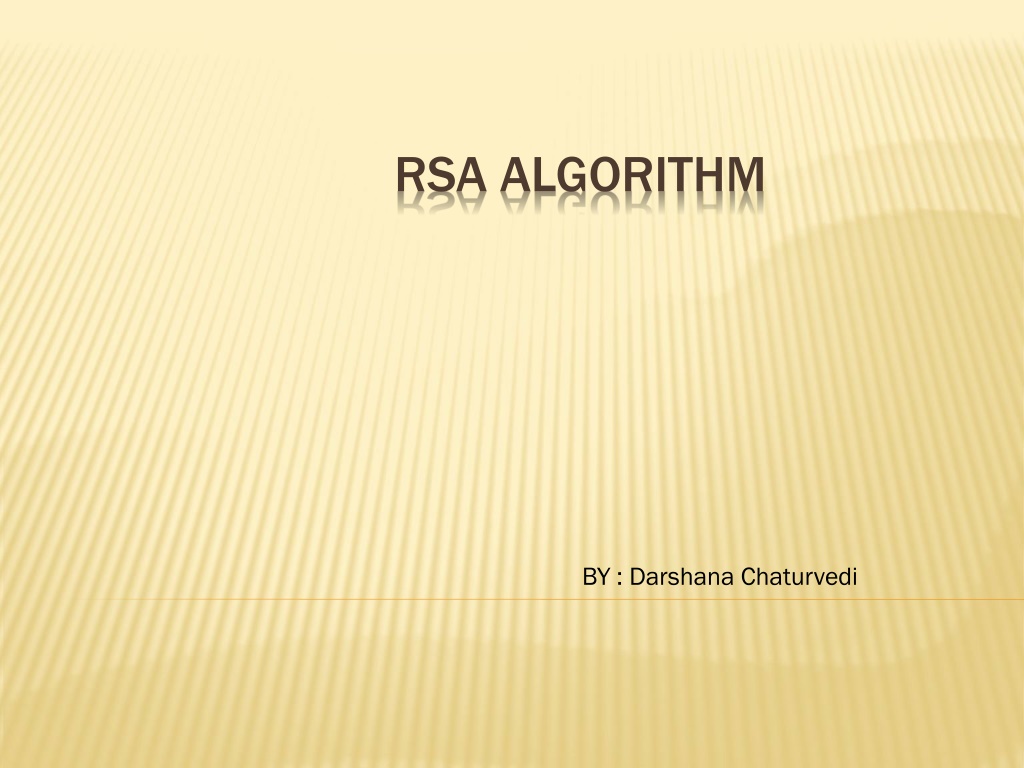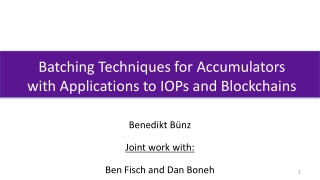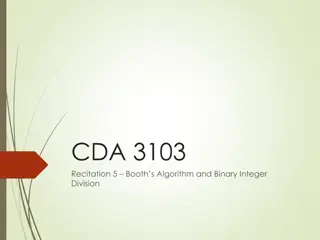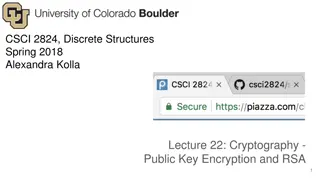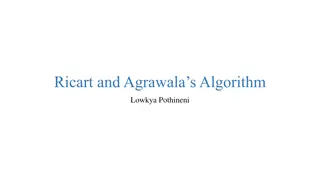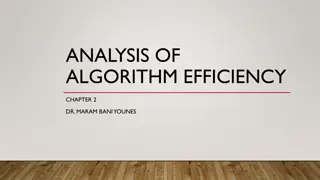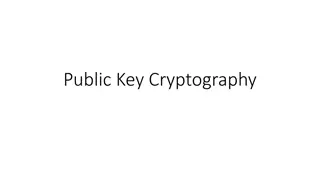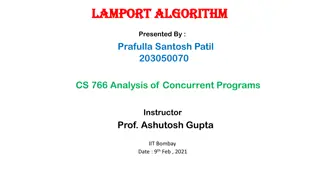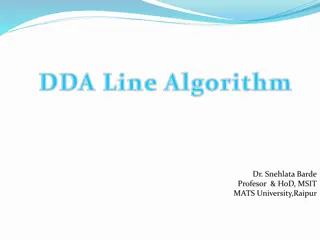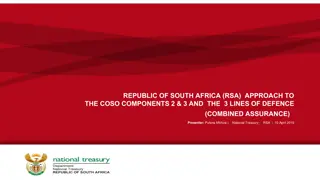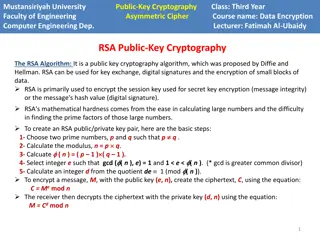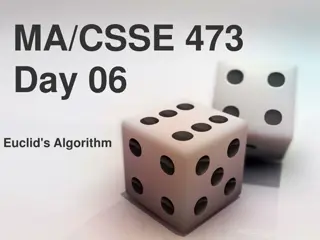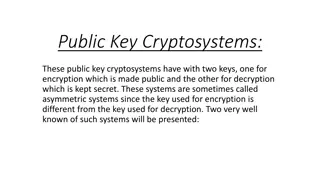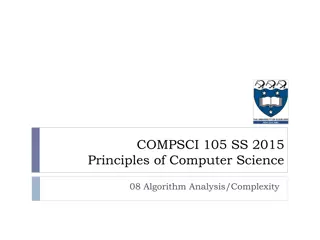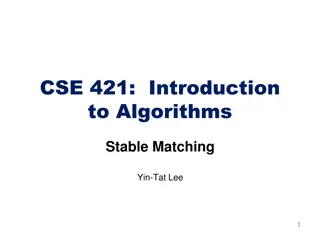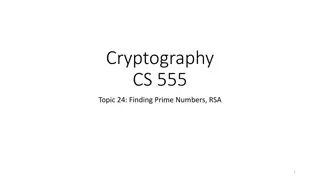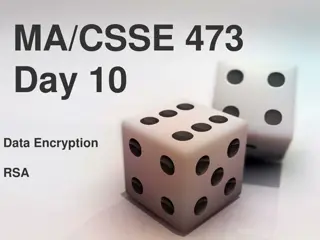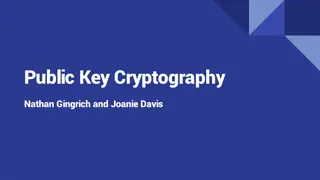RSA Algorithm - An Overview
Cryptography is the science of writing in secret code to protect information. The RSA algorithm, introduced by Rivest, Shamir, and Adleman in 1978, is a popular public key system. It involves the exchange of secure messages between senders and receivers to avoid code breaking. This algorithm uses both public and private keys for encryption and decryption to ensure data security.
Download Presentation

Please find below an Image/Link to download the presentation.
The content on the website is provided AS IS for your information and personal use only. It may not be sold, licensed, or shared on other websites without obtaining consent from the author.If you encounter any issues during the download, it is possible that the publisher has removed the file from their server.
You are allowed to download the files provided on this website for personal or commercial use, subject to the condition that they are used lawfully. All files are the property of their respective owners.
The content on the website is provided AS IS for your information and personal use only. It may not be sold, licensed, or shared on other websites without obtaining consent from the author.
E N D
Presentation Transcript
RSA ALGORITHM BY : Darshana Chaturvedi
OUTLINE INTRODUCTION RSA ALGORITHM EXAMPLES RSA IS EFFECTIVE FERMAT S LITTLE THEOREM EUCLID S ALGORITHM REFERENCES
INTRODUCTION Cryptography Ancient art. Science of writing in secret code. Art of protecting information by encrypting it into an unreadable format, called cipher text which can be decrypted into the plain text using a secret key. Uses Email messages Credit card information Corporate data
CONT.. Types Symmetric-key systems(uses a single key) Public-key systems introduced in 1970 s(uses a public key known to everyone and a private key that only the receiver of the messages uses) Previously both senders and receivers implemented the algorithms by hand but with the advent of computers, things changed.
CONT.. Simplest cryptographic systems Algorithms for both encryption and decryption are fixed and known to everyone. There are two inputs, the text to be encoded or decoded and a key.
CONT.. Symmetric key encryption No message can be sent unless there has been some prior agreement on a key. Even if there is an agreement, if the same key is used over an extended period of time, an eavesdropper may be able to infer the key and break the code.
RSA ALGORITHM New keys must be transmitted between the senders and receivers to avoid code breaking. The most widely used public key system is the RSA algorithm. RSA algorithm [Rivest , Shamir and Adleman] in 1978 We assume that Bob and Alice wish to exchange secure messages and that Eve is attempting to eavesdrop.
CONT.. Assume that Alice wants to send a message to Bob. Then Bob chooses a private key known only to him. Bob exploits a function f to compute his public key, public = f(private). Bob publishes public key. Alice exploits Bob s public key to compute ciphertext= encrypt(plaintext, public) and she sends ciphertext to Bob.
CONT.. Bob exploits his private key to compute plaintext= decrypt(ciphertext, private). In order for this last step to work, encrypt and decrypt must be designed so that one is the inverse of the other.
CONT.. If there exist efficient algorithm for performing all four of the steps, then Bob and Alice will be able to exchange messages. We assume that Eve knows the algorithm encrypt and decrypt . So she could easily eavesdrop if she could infer Bob s private key from his public one or if she could compute decrypt without knowing Bob s private key.
CONT.. RSA algorithm uses the mathematical properties of modular arithmetic and the computational properties of prime numbers to ensure that Bob and Alice can perform their tasks efficiently but Eve cannot.
STEPS Alice uses the RSA algorithm to send a message to Bob as follows. Bob constructs his public and private keys Bob chooses two large prime numbers p and q. From them, he computes n=p*q. Bob, finds a value e such that 1 < e < p.q and gcd(e,(p- 1)(q-1))=1. (in other words, he finds an e such that e and (p-1).(q-1) are relatively prime). Bob computes a value d such that d.e(mod(p-1).(q-1))= 1. In RSA terminology, this value d, rather than the original numbers p and q, is referred to as Bob s private key.
CONT.. Bob publishes (n,e) as his public key. Alice breaks her message plaintext into segments such that no segment corresponds to a binary number that is larger than n. Then, for each plaintext segment, Alice computes ciphertext = plaintexte(mod n). Then she sends ciphertext to Bob. Bob recreates Alice s original message by computing plaintext = ciphertextd(mod n).
EXAMPLE 1 We can illustrate the RSA algorithm with a simple message from Alice to Bob. Bob is expecting to receive messages. So he constructs his keys as follows: He chooses two prime numbers, p=3 and q=11. He computes n=p*q=33. He finds an e such that 1<e<33 and gcd (e,20) = 1. Then e he selects is 7.
CONT.. Then he finds the value of d such that d*e(mod(p- 1)(q-1)) = 1. Hence d is 3 as 3*7(mod 20) = 1.So,3 is the Bob s private key. Bob publishes (33,7) as his public key. Alice wishes to send the simple message 2. So Alice computes 27 (MOD 33) = 29. Alice sends Bob the message 29. Bob uses his private key to recreate Alice s original message by computing 293 (MOD 33) = 2. Hence, Bob decrypts the message and read it.
EXAMPLE 2 Sending message from Alice to Bob Bob is expecting to receive messages. So he constructs his keys as follows: He chooses two prime numbers, p=19 and q=31. He computes n=p*q=589. He finds an e that has no common divisors with 18*30=540. The e he selects is 49.
CONT.. He finds a value d =1069. Notice that 1069*49 =52381. Bob needs to assure that the remainder, when 52381 is divided by 540, is 1. And it is :52381=540*97+1. Bob s private key is now 1069. Bob publishes (589,49) as his public key.
CONT.. Alice wishes to send the simple message A . The ASCII code for A is 65. So Alice computes 6549(mod589). She does without actually computing 6549. Instead, she exploits the following two facts: ni+j=ni*nj (n*m)(mod k) =(n(mod k)*m(mod k))(mod k) Combining these, we have: ni+j(mod k) = (ni(mod k)*nj(mod k))(mod k)
CONT.. So, to compute 6549,first observe that 49 can be expressed in binary as 110001. So 49 = 1+16+32 Thus, 6549 = 651+16+32.The following table lists the required powers 65: 651(mod589)=65 652(mod589)=4225(mod589)=102 654(mod589)=1022(mod589)=10404(mod589)=391
CONT.. 658(mod589)=3912(mod589)=152881(mod589)=330 6516(mod589)=3302(mod589)=108900(mod589)=524 6532(mod589)=5242(mod589)=274576(mod589)=102 So we have:6549(mod589) = 651+16+32(mod589) =(651*6516*6532)(mod589) =((651(mod589))*(6516(mod589))*(6532(mod589)))(mo d589)
CONT.. =(65*524*102)(mod589) =((34060(mod589))*102)(mod589) =(487*102)(mod589) =198 Alice sends Bob the message 198. Bob uses his private key(1069) to recreate Alice s message by computing 1981069(mod589). Using the same process Alice used, he does this efficiently and retrieves the message 65.
RSA IS EFFECTIVE The function encrypt and decrypt are inverse of each other and it is proved using euler s generalization of Fermat s Little theorem. Bob can choose primes efficiently using the following algorithm. Randomly choose two candidates. Check the candidates to see if they are prime. This can be done efficiently using a randomized algorithm, Fermat s Little theorem. large numbers as
FERMATS LITTLE THEOREM If p is prime , then, for any integer a, if gcd(a,p) = 1, ap- 1 1 (mod p). Where , x y (mod p) means x and y have the same remainder when divided by p. Example : p = 5 and a = 3, then , 3 (5-1)= 81 1 (mod 5) which is true. So, 5 passes the Fermat test at a = 3. If p fails the Fermat s test at a then we will say that a is a Fermat witness that p is composite.
CONT.. The theorem tells us that if p is prime ,then it must pass the Fermat test at every appropriately chosen value of a. QUESTION : If p passes the Fermat test at some value of a , do we know that p is prime? ANSWER : No Conclusion : If p is composite and yet it passes the Fermat test at a , we will say that a is a Fermat Liar that p is prime.
CONT.. Randomly choose values for a looking for a witness that p is composite. Note : Consider the values which are less then p only. So, if p is prime then gcd(a,p) is always 1. No need to evaluate gcd anymore in our algorithm. If we fail to find a witness that shows that p is composite, we will report that p is prime. As liars exists, increase the likelihood of finding such a witness , if one exists, by increasing the witnesses that we test.
CONT.. Algorithm : Input : A value to be tested and the possible witnesses to be checked. Output : Composite or Probably Prime number. simpleFermat(p:integer,k:integer) = Do k times. - Select a in range 2 to p-1 - If ap-1 1 is not true , return Composite If all tests passed then return Probably Prime.
CONT.. Some composite numbers pass the test at all values of a and are called Carmichael numbers . Every value of a is a Fermat liar for every Carmichael number, so no value of k will enable simpleFermat to realize that a Carmichael number is not prime.
EUCLIDS ALGORITHM Successive division of 2 numbers followed by the resulting remainder divided into the divisor of each division until the remainder is equal to zero. Then the remainder of the previous division is the gcd. Example : Divident = Quotient * Divisor + Remainder If a = 1071 and b = 462, gcd (1071,462) is : Then, 1071 = 2 * 462 + 147 462 = 3 * 147 + 21 147 = 7 * 21 + 0 Stop, as remainder is 0. gcd (1071,462) = 21
REFERENCES Automata, Computability, and Complexity| Theory and Applications by Elaine Rich. En.wikipedia.org Presentation from the previous class
